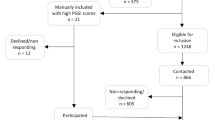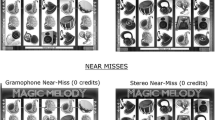Abstract
During slot machine gambling, near-miss outcomes occur when the final winning icon lands one position off the pay-line. To understand how near-misses promote gambling behaviour in healthy populations, autonomic arousal is often used to index outcome response valence. Findings remain equivocal, possibly owing to the limited ecological validity of computer simulations. Relevant psychological traits, such as impulsivity, which increase the risk of problem gambling, are often not examined. Here, we used immersive virtual reality (VR) to investigate near-miss-induced changes in physiological arousal and VR gambling behaviour. Sixty adult participants with no history of problem gambling were immersed in a VR casino-bar where they engaged with a self-selected slot machine. Real-time heart rate (HR) data were acquired during immersion. Within-subjects analyses were conducted on HR and post-reinforcement pauses (PRPs; i.e., time taken to initiate next-spin) across wins, losses and near-misses. Significant HR acceleration occurred for both near-misses and losses compared to wins, indexing an initial orientation response. Both types of losses were associated with faster next-spin responses. Near-misses did not apparently have unique HR or PRP profiles from losses, although this may reflect our loss control condition, which in itself may have been a subtler near-miss outcome. Impulsivity measured by the SUPPS-P was not associated with near-miss responses. Losses may encourage gambling as participants experience more immediate HR acceleration (indexing arousal unique to losing) and initiate faster responses. Future studies should clarify this effect by investigating problem gambling cohorts and develop VR paradigms taking into consideration the current findings and limitations.







Similar content being viewed by others
References
Amsel, A. (1958). The role of frustrative nonreward in noncontinuous reward situations. Psychological Bulletin, 55(2), 102.
Amsel, A. (1992). Frustration theory: An analysis of dispositional learning and memory (Vol. 11). Cambridge: Cambridge University Press.
Anderson, G., & Brown, R. I. (1984). Real and laboratory gambling, sensation-seeking and arousal. British Journal of Psychology, 75(3), 401–410.
Barry, R. J. (2006). Promise versus reality in relation to the unitary orienting reflex: A case study examining the role of theory in psychophysiology. International Journal of Psychophysiology, 62(3), 353–366. https://doi.org/10.1016/j.ijpsycho.2006.01.004.
Barton, K., Yazdani, Y., Ayer, N., Kalvapalle, S., Brown, S., Stapleton, J., et al. (2017). The effect of losses disguised as wins and near misses in electronic gaming machines: A systematic review. Journal of Gambling Studies. https://doi.org/10.1007/s10899-017-9696-0.
Belisle, J., & Dixon, M. R. (2016). Near misses in slot machine gambling developed through generalization of total wins. Journal of Gambling Studies, 32(2), 689–706. https://doi.org/10.1007/s10899-015-9554-x.
Blain, B., Richard Gill, P., & Teese, R. (2015). Predicting problem gambling in Australian adults using a multifaceted model of impulsivity. International Gambling Studies, 15(2), 239–255. https://doi.org/10.1080/14459795.2015.1029960.
Bouchard, S., Loranger, C., Giroux, I., Jacques, C., & Robillard, G. (2014). Using virtual reality to provide a naturalistic setting for the treatment of pathological gambling. In C. S. Lányi (Ed.), The thousand faces of virtual reality. InTech: Rijeka.
Bouchard, S., Robillard, G., Giroux, I., Jacques, C., Loranger, C., St-Pierre, M., et al. (2017). Using virtual reality in the treatment of gambling disorder: The development of a new tool for cognitive behavior therapy. Frontiers in Psychiatry. https://doi.org/10.3389/fpsyt.2017.00027.
Bradley, M. M., & Lang, P. J. (2000). Emotion and Motivation. Handbook of Psychophysiology, 2, 602–642.
Chase, H. W., & Clark, L. (2010). Gambling severity predicts midbrain response to near-miss outcomes. The Journal of Neuroscience, 30(18), 6180. https://doi.org/10.1523/JNEUROSCI.5758-09.2010.
Clark, L., Crooks, B., Clarke, R., Aitken, M. R., & Dunn, B. D. (2012). Physiological responses to near-miss outcomes and personal control during simulated gambling. Journal of Gambling Studies, 28(1), 123–137. https://doi.org/10.1007/s10899-011-9247-z.
Clark, L., Lawrence, A. J., Astley-Jones, F., & Gray, N. (2009). Gambling near-misses enhance motivation to gamble and recruit win-related brain circuitry. Neuron, 61(3), 481–490. https://doi.org/10.1016/j.neuron.2008.12.031.
Clark, L., Liu, R., McKavanagh, R., Garrett, A., & Dunn, B. (2013). Learning and affect following near-miss outcomes in simulated gambling. Journal of Behavioral Decision Making, 26(5), 442–450. https://doi.org/10.1002/bdm.1774.
Cyders, M., Littlefield, A., Coffey, S., & Karyadi, K. (2014). Examination of a short English version of the UPPS-P Impulsive Behavior Scale. Addictive Behaviors, 39(9), 1372. https://doi.org/10.1016/j.addbeh.2014.02.013.
Dixon, M., Harrigan, K., Jarick, M., Maclaren, V., Fugelsang, J., & Sheepy, E. (2011). Psychophysiological arousal signatures of near-misses in slot machine play. International Gambling Studies, 11(3), 393–407. https://doi.org/10.1080/14459795.2011.603134.
Dixon, M., Harrigan, K. A., Sandhu, R., Collins, K., & Fugelsang, J. A. (2010). Losses disguised as wins in modern multi-line video slot machines. Addiction, 105(10), 1819–1824. https://doi.org/10.1111/j.1360-0443.2010.03050.x.
Dixon, M., MacLaren, V., Jarick, M., Fugelsang, J. A., & Harrigan, K. A. (2013). The frustrating effects of just missing the jackpot: Slot machine near-misses trigger large skin conductance responses, but no post-reinforcement pauses. Journal of Gambling Studies, 29(4), 661–674. https://doi.org/10.1007/s10899-012-9333-x.
Dixon, M. R., & Schreiber, J. E. (2004). Near-miss effects on response latencies and win estimations of slot machine players. Psychological Record, 54(3), 335.
Dowling, N., Smith, D., & Thomas, T. (2005). Electronic gaming machines: Are they the ‘crack-cocaine’of gambling? Addiction, 100(1), 33–45.
Ferris, J., & Wynne, H. (2001). The Canadian problem gambling index. Ottawa: Canadian Consortium for Gambling Research.
Field, A. (2013). Discovering statistics using IBM SPSS statistics. Thousand Oaks: Sage.
Gainsbury, S., Russell, A., Hing, N., Wood, R., Lubman, D. I., & Blaszczynski, A. (2014). The prevalence and determinants of problem gambling in Australia: Assessing the impact of interactive gambling and new technologies. Psychology of Addictive Behaviors, 28(3), 769. https://doi.org/10.1037/a0036207.
Gerstein, D., Volberg, R. A., Toce, M., Harwood, H., Johnson, R., Buie, T., et al. (1999). Gambling impact and behavior study: Report to the national gambling impact study commission. Chicago: National Opinion Research Center.
Giroux, I., Faucher-Gravel, A., St-Hilaire, A., Boudreault, C., Jacques, C., & Bouchard, S. (2013). Gambling exposure in virtual reality and modification of urge to gamble. Cyberpsychology Behavior Social Networking, 16(3), 224–231. https://doi.org/10.1089/cyber.2012.1573.
Goudriaan, A. E., Yücel, M., & van Holst, R. J. (2014). Getting a grip on problem gambling: What can neuroscience tell us? Frontiers in Behavioral Neuroscience. https://doi.org/10.3389/fnbeh.2014.00141.
Griffiths, M. (1991). Psychobiology of the near-miss in fruit machine gambling (slot machines). The Journal of Psychology, 125(3), 347.
Griffiths, M. (1993). Fruit machine gambling: The importance of structural characteristics. Journal of Gambling Studies, 9(2), 101–120.
Harrigan, K. A. (2009). Slot machines: Pursuing responsible gaming practices for virtual reels and near misses. International Journal of Mental Health and Addiction, 7(1), 68–83.
Hodgins, D. C. (2002). Using the NORC DSM Screen for gambling problems (NODS) as an outcome measure for pathological gambling: Reliability and validity. Gambling Research: Journal of the National Association for Gambling Studies (Australia), 14(1), 5.
Kassinove, J. I., & Schare, M. L. (2001). Effects of the “near miss” and the “big win” on persistence at slot machine gambling. Psychology of Addictive Behaviors, 15(2), 155.
Kennedy, R. S., Lane, N. E., Berbaum, K. S., & Lilienthal, M. G. (1993). Simulator sickness questionnaire: An enhanced method for quantifying simulator sickness. The International Journal of Aviation psychology, 3(3), 203–220. https://doi.org/10.1207/s15327108ijap0303_3.
Knezevic, B., & Ledgerwood, D. M. (2012). Gambling severity, impulsivity, and psychopathology: Comparison of treatment-and community-recruited pathological gamblers. The American Journal on Addictions, 21(6), 508–515.
Krueger, T. H. C., Schedlowski, M., & Meyer, G. (2005). Cortisol and heart rate measures during casino gambling in relation to impulsivity. Neuropsychobiology, 52(4), 206–211. https://doi.org/10.1159/000089004.
Lacey, J. I. (1967). Somatic response patterning and stress: Some revisions of activation theory. In M. H. Appley & R. Trumbell (Eds.), Psychological stress: Issues in research (pp. 14–42). New York: Appleton-Century-Croft.
Lacey, J. I., Kagan, J., Lacey, B. C., & Moss, H. (1963). The visceral level: Situational determinants and behavioral correlates of autonomic response patterns. In P. H. Knapp (Ed.), Expression of the emotions in man (pp. 161–196). New York: International Univeristies Press.
Li, E., Browne, M., Rawat, V., Langham, E., & Rockloff, M. (2017). Breaking bad: Comparing gambling harms among gamblers and affected others. Journal of Gambling Studies, 33(1), 223–248.
Lole, L., Gonsalvez, C. J., Blaszczynski, A., & Clarke, A. R. (2012). Electrodermal activity reliably captures physiological differences between wins and losses during gambling on electronic machines. Psychophysiology, 49(2), 154–163. https://doi.org/10.1111/j.1469-8986.2011.01290.x.
Lutri, V., Soldini, E., Ronzitti, S., Smith, N., Clerici, M., Blaszczynski, A., et al. (2018). Impulsivity and gambling type among treatment-seeking disordered gamblers: An explorative study. Journal of Gambling Studies, 34, 1341–1354.
Lynam, D. (2013). Development of a short form of the UPPS-P Impulsive Behavior Scale. Unpublished Technical Report.
Moss, J. D., & Muth, E. R. (2011). Characteristics of head-mounted displays and their effects on simulator sickness. Human Factors, 53(3), 308–319.
Park, C. B., Park, S. M., Gwak, A. R., Sohn, B. K., Lee, J. Y., Jung, H. Y., et al. (2015). The effect of repeated exposure to virtual gambling cues on the urge to gamble. Addictive Behaviors, 41, 61–64. https://doi.org/10.1016/j.addbeh.2014.09.027.
Parke, J., & Griffiths, M. (2006). The psychology of the fruit machine: The role of structural characteristics. International Journal of Mental Health and Addiction, 4(2), 151–179. https://doi.org/10.1007/s11469-006-9014-z.
Productivity Commission. (2010). Gambling Canberra.
Reid, R. (1986). The psychology of the near miss. Journal of Gambling Behavior, 2(1), 32–39. https://doi.org/10.1007/BF01019932.
Robillard, G., Bouchard, S., Fournier, T., & Renaud, P. (2003). Anxiety and presence during VR immersion: A comparative study of the reactions of phobic and non-phobic participants in therapeutic virtual environments derived from computer games. CyberPsychology & Behavior, 6(5), 467–476. https://doi.org/10.1089/109493103769710497.
Sharman, S., Aitken, M. R., & Clark, L. (2015). Dual effects of losses disguised as wins’ and near-misses in a slot machine game. International Gambling Studies, 15(2), 1–12. https://doi.org/10.1080/14459795.2015.1020959.
Sharman, S., & Clark, L. (2016). Mixed emotions to near-miss outcomes: A psychophysiological study with facial electromyography. Journal of Gambling Studies, 32(3), 823–834. https://doi.org/10.1007/s10899-015-9578-2.
Toce-Gerstein, M., Gerstein, D. R., & Volberg, R. A. (2003). A hierarchy of gambling disorders in the community. Addiction, 98(12), 1661–1672.
Ulrich, N., Ambach, W., & Hewig, J. (2016). Severity of gambling problems modulates autonomic reactions to near outcomes in gambling. Biological Psychology, 119, 11–20. https://doi.org/10.1016/j.biopsycho.2016.06.005.
Williams, R. J., Volberg, R. A., & Stevens, R. M. (2012). The population prevalence of problem gambling: Methodological influences, standardized rates, jurisdictional differences, and worldwide trends. Ontario Problem Gambling Research Centre.
Witmer, B. G., & Singer, M. J. (1998). Measuring presence in virtual environments: A presence questionnaire. Presence Teleoperators and Virtual Environments, 7(3), 225–240.
Worhunsky, P. D., Malison, R. T., Rogers, R. D., & Potenza, M. N. (2014). Altered neural correlates of reward and loss processing during simulated slot-machine fMRI in pathological gambling and cocaine dependence. Drug and Alcohol Dependence, 145, 77–86. https://doi.org/10.1016/j.drugalcdep.2014.09.013.
Wulfert, E., Roland, B. D., Hartley, J., Wang, N., & Franco, C. (2005). Heart rate arousal and excitement in gambling: Winners versus losers. Psychology of Addictive Behaviors, 19(3), 311–316. https://doi.org/10.1037/0893-164X.19.3.311.
Yücel, M., Carter, A., Allen, A. R., Balleine, B., Clark, L., Dowling, N. A., et al. (2017). Neuroscience in gambling policy and treatment: An interdisciplinary perspective. The Lancet Psychiatry, 4(6), 501–506. https://doi.org/10.1016/S2215-0366(16)30369-8.
Yücel, M., Carter, A., Harrigan, K., van Holst, R. J., & Livingstone, C. (2018). Hooked on gambling: A problem of human or machine design? The Lancet Psychiatry, 5(1), 20–21.
Acknowledgements
This research was supported by partial funding from Monash University School of Psychological Science and the David Winston Turner Endowment Fund.
Funding
Murat Yücel has received funding from the National Health and Medical Research Council of Australia (APP#1117188), the Australian Research Council, the David Winston Turner Endowment Fund, and Monash University. He has also received funding from the law firms in relation to expert witness report/statement.
Author information
Authors and Affiliations
Corresponding author
Ethics declarations
Conflict of interest
The authors declare that they have no conflict of interest.
Ethical Approval
All procedures performed in this study involving human participants were in accordance with the ethical standards of the Monash University Human Research Ethics Committee and with the 1964 Helsinki declaration and its later amendments or comparable ethical standards.
Additional information
Publisher's Note
Springer Nature remains neutral with regard to jurisdictional claims in published maps and institutional affiliations.
Rights and permissions
About this article
Cite this article
Detez, L., Greenwood, LM., Segrave, R. et al. A Psychophysiological and Behavioural Study of Slot Machine Near-Misses Using Immersive Virtual Reality. J Gambl Stud 35, 929–944 (2019). https://doi.org/10.1007/s10899-018-09822-z
Published:
Issue Date:
DOI: https://doi.org/10.1007/s10899-018-09822-z




